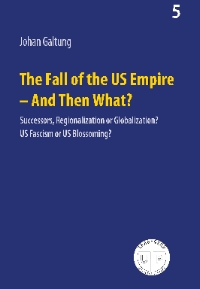After the US Empire: A World of Regions?
EDITORIAL, 5 Aug 2024
#860 | Prof. Johan Galtung - TRANSCEND Media Service
A key hypothesis in the recent The Fall of the US Empire – And Then What? is that the successor system to the US empire will be neither a hegemony run by one big actor like China or the EU, nor globalization run by the TNCs, but a world of regions with regional currencies. A global common currency may come. But the regions will dominate, the state system is fading and real globalization at a distance.
Four regions have crystallized so far: the European Union (EU, 27 members), the African Union (AU, 53 members), the South Asian Area for Regional Cooperation (SAARC, 7 members) and the Association of Southeast Asian Nations (ASEAN, 10 members).
Three areas are in the process of regionalization: Shanghai Cooperation Organization (SCO, 6 members, 3 observers), Latin America (LA, 20+ members), Organization of the Islamic Community (OIC, as a deepening of the present OIC where C stands for Conference, with 56 members, from Morocco to Mindanao).
Why this regionalization? Because quick transportation and real time communication transcend state borders, and because cultural vicinities and affinities block globalization with one state, the world, and one nation, humanity. That will come.
Defense against the US and the UN has been one reason for grouping together, but equally so, with no UN veto power. In this there is a warning to would-be USA successors like the EU.
Five countries are not clearly included in these processes:
UK, an archipelago, sending settlers to the following three;
USA, bi-oceanic and walled, settler colonialist, God-chosen;
Israel, mono-oceanic and walled, settler colonialist, God-chosen;
Australia, an island, settler colonialist;
Japan, an archipelago, God-chosen.
And Russia, which may one day become a multi-cultural region.
Will they one day constitute their own region?
Or, will younger people in the UK prefer EU, in Japan the SCO, in Israel a Middle Eastern Community, and in Australia the SCO? Leaving the USA in splendid isolation, with Canada for comfort? Or, with Russia, reminiscing good, old, superpower days? Or, promising, with Mexico in a North-American MEXUSCAN?
Of these regions EU, LA, OIC and SAARC are relatively mono-civilizational, albeit with huge minorities, and AU, ASEAN and SCO are poly-civilizational, eclectic. They mirror the next system, a globalized world, and prepare their citizens better. Moreover, having other regions built in, may dampen conflicts.
From the premise that the US empire was interventionist (243 since the start under Thomas Jefferson) and killing (maybe 13-17 million in overt and 6 million+ in covert operations in the 73 interventions since the Second world war) follows neither that a successor system is peaceful, nor the opposite.
With seven regions we have seven relations within, and 21 bilateral relations between the regions, altogether 28. Let us have a look, with “0” meaning no relation, “OK” meaning that, ? that there are problems and !!! gross problems:
| EU | AU | SAARC | ASEAN | SCO | LA | OIC | |
|---|---|---|---|---|---|---|---|
| EU | OK | ? | OK | OK | OK | ? | OK |
| AU | ? | 0 | 0 | OK | 0 | ? | |
| SAARC | ? | OK | OK | 0 | !!! | ||
| ASEAN | OK | OK | 0 | OK | |||
| SCO | OK | 0 | OK | ||||
| LA | OK | 0 | |||||
| OIC | ? |
Needless to say, this is highly speculative, but some conclusions follow nevertheless.
Thus, the regional world does not look that bad, with 7 0, 14 OK, 6 ? (like EU penetrating AU and LA, intra-region problems) and 1 !!! (SAARC-OIC); the worst problem in the whole configuration. Why?
Because India stands at the crossroad between 1.3 billion Muslims West-East when their ummah takes political shape as a region, OIC, and about the same number of Hindus North-South in a region already shaping up. The 160 million or so Muslims inside India are caught in the middle. And the West cannot deny the ummah a khalifat institution when the West has its Vatican.
Several options, none of them satisfactory, may be tried.
India could become the seat of the khalifat, by invitation; after all, only Indonesia has more Muslims. The Hindu tradition of accommodating all, as Mother of religions, could be useful.
Islam and Hinduism could come closer together, as Islamo-Hinduism, countering Judeo-Christianity (and its fundamentalist branch, Christian Zionism) from the West; possibly solving the SAARC-OIC problem at the expense of creating a larger one.
In due time this could be the basis for a joint region, based on the ecumenical nature of both religions.
There could also be mutual avoidance, traffic being organized like two highways crossing at two levels.
But, however this is done, what the SAARC-OIC multi-region needs is a peaceful, transformed, Kashmir, not a powder-keg fuse. Time has come for moving forward at a less glacial speed. But the truth is probably that both India and Pakistan are hoping for the other to collapse so they can pick up the spoils. Right now Pakistan is very fragile and India relatively solid; some time ago it was the other way around.
Evidently a regionalized world needs a truly globalized UN to help mitigate their relations, with all regions members of a very different Peace and Security Council (taking the name from the African Union); without that feudal relic, the veto power. And, equally evidently, much has to be the regions’ own job, bilaterally and multilaterally. As the lights of Anglo-America are fading quickly time is coming for ex oriente lux, and more particularly from China and India, Chindia–with Russia 40% of humanity, and the core of SCO. Two of the oldest civilizations on earth, with continuities of thousands of years, as opposed to the rather recent UK and its progeny of yesterday, the USA.
In the richness of oriental light some spectral lines stand out, illuminating a world hoping for better guidance than one killing intervention after the other:
– the gandhism of India, hoping that India will also be ever more inspired by one of the greatest humans ever, their own;
– the daoism of China, hoping that China will also be ever more inspired by some of the greatest insights ever, their own;
– the Panchsheel of them both, the Five Principles (mutual respect for territorial integrity and sovereignty, mutual non-aggression, mutual non-interference, equality and mutual benefit, peaceful co-existence), as world guidelines, but also:
– the panca sila of Indonesia (one nation, humanitarianism, democracy and consent, social prosperity, one god–meaning faith, guidance), as domestic guidelines.
Nonviolence, sophistication, world, and domestic traffic rules as opposed to endless interventionism for whatever purpose. May the current Asian blend of age-old wisdom and youthful energy inspire a world filled with pessimism and fear.
____________________________________________________
Originally published on 27 Jul 2009 – #72
 Johan Galtung (24 Oct 1930 – 17 Feb 2024), a professor of peace studies, dr hc mult, was the founder of TRANSCEND International, TRANSCEND Media Service, and rector of TRANSCEND Peace University. He was nominated for the Nobel Peace Prize numerous times and was awarded among others the 1987 Right Livelihood Award, known as the Alternative NPP. Galtung has mediated in over 150 conflicts in more than 150 countries, and written more than 170 books on peace and related issues, 96 as the sole author. More than 40 have been translated to other languages, including 50 Years-100 Peace and Conflict Perspectives published by TRANSCEND University Press. His book, Transcend and Transform, was translated to 25 languages. He has published more than 1700 articles and book chapters and over 500 Editorials for TRANSCEND Media Service. More information about Prof. Galtung and all of his publications can be found at transcend.org/galtung
Johan Galtung (24 Oct 1930 – 17 Feb 2024), a professor of peace studies, dr hc mult, was the founder of TRANSCEND International, TRANSCEND Media Service, and rector of TRANSCEND Peace University. He was nominated for the Nobel Peace Prize numerous times and was awarded among others the 1987 Right Livelihood Award, known as the Alternative NPP. Galtung has mediated in over 150 conflicts in more than 150 countries, and written more than 170 books on peace and related issues, 96 as the sole author. More than 40 have been translated to other languages, including 50 Years-100 Peace and Conflict Perspectives published by TRANSCEND University Press. His book, Transcend and Transform, was translated to 25 languages. He has published more than 1700 articles and book chapters and over 500 Editorials for TRANSCEND Media Service. More information about Prof. Galtung and all of his publications can be found at transcend.org/galtung
Tags: Anti-hegemony, Anti-imperialism, Anti-militarism, Anti-war, Fascism, Johan Galtung, Multipolar World Order, US empire
This article originally appeared on Transcend Media Service (TMS) on 5 Aug 2024.
Anticopyright: Editorials and articles originated on TMS may be freely reprinted, disseminated, translated and used as background material, provided an acknowledgement and link to the source, TMS: After the US Empire: A World of Regions?, is included. Thank you.
If you enjoyed this article, please donate to TMS to join the growing list of TMS Supporters.

This work is licensed under a CC BY-NC 4.0 License.
Join the discussion!
We welcome debate and dissent, but personal — ad hominem — attacks (on authors, other users or any individual), abuse and defamatory language will not be tolerated. Nor will we tolerate attempts to deliberately disrupt discussions. We aim to maintain an inviting space to focus on intelligent interactions and debates.
